Last Updated on: 16th January 2018, 05:07 am
Yogyakarta, also referred to as Jogja, has long been a hub for culture and arts in Indonesia. Artists of all mediums and styles continue to flock to the city thanks to its creative culture and affordable living. Today, the central Javan city is the best place in the country, if not all of Asia, to discover street art. Even if the main purpose of your trip is to see Borobudur, Prambanan or to climb Mt. Merapi, no visit to Jogja is complete without sampling its amazing collection of public art.
Though I’d intended to spend time exploring Yogyakarta’s street art scene even before my visit, I wasn’t quite prepared for what I encountered. The sheer volume of Jogja’s public art is absolutely staggering. The works featured below represent only a small fraction of what I saw and photographed. And I’m sure there are many more areas that I have yet to discover. Even after a week in the city, I can’t help but feel like I only scratched the surface of what there is to see.
Hunting For Street Art in Jogja
When hunting for street art in any city, you need to be aware that things are always changing. Even ‘legal’ street art may not be there forever, while murals painted without permission could be washed off or painted over at any time. Some of the works pictured below may no longer be there by the time you visit Yogyakarta. And sadly, some may no longer exist even at the time of writing!
I visited Yogyakarta at the end of May 2017. As much as I wanted to create a detailed guide that people could use for years to come, this article is probably best thought of as a snapshot of the city’s public art scene at the time of my visit.
Fortunately, Jogja’s creative spark does not seem like it’s going to die out any time soon. Whether you visit this month or five years from now, you’re no doubt going to make some excellent discoveries.
To get a good overview of Yogyakarta’s street art scene, you will need at least a couple days in the city, but ideally more. Luckily, it’s fairly easy to combine street art exploration with visits to the city’s numerous galleries and art spaces.
This article divides the city up into sections relative to the sultan’s palace, or kraton, which sits at the city center. Though not covered here, some people also say that good street art can be found on the side streets off of Malioboro Street as well as the area around the Taman Suri water palace.
Before breaking down Jogja’s street art by area, here are a couple of artists you’re bound to spot again and again no matter where you base yourself in the city:
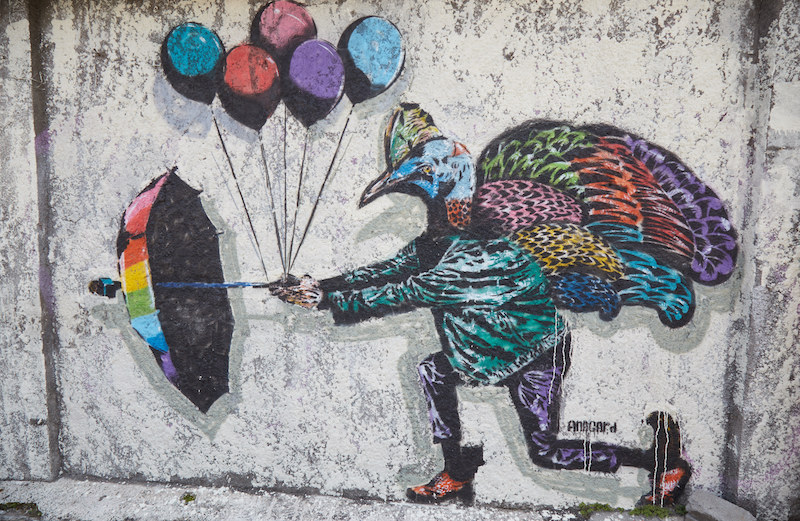
Anagard
Anagard's works have a distinct style that you'll instantly recognize after just a short time in the city. His murals usually feature just one or two humanlike figures, but the faces are either that of an animal's or are obscured by some type of mask. While most of his works don't take up a whole lot of space, they don't need to in order to grab your attention.Anagard has also displayed work in places like Lithuania, Poland and Sweden. Though his works are generally abstract, there are subtle hints of an 'ant-extremism' message throughout his paintings.

Love Hate Love
Love Hate Love is by far one of the most active street artists in the city. He's known for his trademark colorful faces and sideways heads. The speech bubbles emerging from the characters range from funny and absurd to philosophical. “Life is about creating yourself,” reads one of the murals. “Graffiti saved my sex life,” reads another. Another urges people to support living artists because “the dead ones don't need the money.” This is something I kept in mind during my t-shirt buying spree over the course of the week.

Southern Jogja
There’s an unbelievable amount of art to be found around Jl. Tirtodipuran and Jl. Prawirotaman, the same east-west street that changes its name after crossing the north-south Jl. Parangtritis. This would also be the best area to base yourself, as there’s plenty of affordable accommodation in the area.
Around 'Lanpangan Minggiran' Field
A good place to start would be the Lanpangan Minggiran football field. Very high quality murals can be found on the streets around the field in all directions. When finished, head to the main east-west street and turn right.
Jl. Dl Panjaitan
After heading east for just a little bit, you’ll get to the intersection with Jl. Dl Panjaitan. This street has some good public art as well as some famous art galleries, like Cemeti Art House. You can head north for a bit to check it out, or save it for another time when you’re headed in that direction to see the palace.
Jl. Tirtodipuran & Side Streets
Now heading east on Jl. Tirtodipuran, there’s plenty to explore in the little alleyways on either side of it, as well as the smaller streets that run parallel to it, like Jl. Sartono. There is so much to see around this one part of Jogja that you could easily spend a couple of hours walking around. Just when you think you’ve seen it all, you’ll come across more. And more, and more.
Jl. Prawirotaman & The Abandoned Building
Once you get to Jl. Prawirotaman, the amount of art dies down a little bit, as this is a relatively crowded area full of bars, restaurants and backpacker hostels. One thing you might come across, though, is an abandoned building on the right hand (south) side of the street.
I can’t say for certain whether or not it still even exists at the time of writing, but it’s fun to take a little walk in if you find it. The graffiti here is not as refined as further down the street, but this is a must if you like exploring abandoned spaces. If you’ve ever been to Bali, this is like a miniature version of Taman Festival, the deserted theme park now covered in art. Just be sure to watch out for all the broken glass on the ground.
You could head all the way east and get to the next major intersection, where you might come across some works by Anagard. Or, head back to Jl. Parangtritis and head north. Just by the large intersection where four streets meet, you may or may not come across what’s known as the ‘ILLEGALLERY.’

The ILLEGALLERY & Public Art in Jogja
The corner of Jl. Brigien Katamso and Jl. Kol. Sugiyono streets is home to a strange sight. A stuffed dummy wearing a red helmet hangs from a large door with the words “ILLEGALLERY #4” painted over it. Stop by at the right time, and you may even spot a traditional orchestra performing outside. But what is the ILLEGALLERY and why is this display different from the countless other public artworks spread throughout Yogyakarta?
Though there are no permanent staff members at the ‘gallery’ and English information about the project is scarce, the purpose of ILLEGALLERY seems to be just as political as it is creative. Namely, the project is meant to provoke public debate as to what can be considered either ‘public’ or ‘private’ space. Throughout my wanderings around the city, I was often curious about the same thing.
“There are no clear lines between what’s legal and illegal here. Artists just go ahead and paint empty walls,” one local artist told me. “If the owner doesn’t like it, they’ll paint over it. If they don’t mind, they just leave it up.”
Later on in the week, I was sipping a cold drink outside a convenience store while admiring a piece by Anagard just next to it. A local approached me we got talking about the murals all over the city. He said that paintings like the Anagard piece we were looking at are often commissioned by the building owners themselves.
Whatever the case may be, it appears that graffiti and mural artists pretty much have free reign in Jogja. What’s technically illegal is for the large part tolerated, and showcasing one’s work throughout the city may even lead to paid opportunities down the road.
As no serious crackdown against street art seems to be taking place in Yogyakarta, it’s unclear, then, what the ILLEGALLERY project is really hoping to accomplish. Nevertheless, the premise is a fun one. As can be seen in this video documenting the project’s previous incarnation, a group of artists takes over a space in the middle of the night. By morning, it gets completely transformed – to either the delight or confusion of the next day’s commuters.
Northern Jogja
There’s not quite as much to see in the northern part of the city, at least from my impressions. One particular area known for its public art is the exterior of Stadion Kridosono. The walls surrounding the stadium are almost entirely covered in murals, although a good chunk of the stadium has now been covered with unappealing gray paint.
Overall, the murals here are not as high quality as what you can find in the south, but you may be able to spot a few gems. Getting a closer look is very difficult, as the traffic around the stadium literally never stops.
Nearby you can also find some artwork made by local students. This shows how even young school children are being encouraged to publicly display their work. Sadly, though, some of the pieces have already been vandalized by ugly tags.
Southwest Jogja (Sejeblog Neighborhood)
I made a fascinating discovery while wandering around the rural area west of the city on my way to visit some art galleries. On a quiet street surrounded by rice paddies, I first noticed an eerie mural by French artist Vivien Poly of a man with four eyes. Intrigued, I decided to walk further down the street, only to discover what I’d consider some of Jogja’s best murals.
I later learned that all the paintings were fresh, having only been put up in April 2017, roughly a month or so before my visit. These were all part of a project called ‘Sejeblog Neighborhood Street Art,’ featuring such notable participants as Anagard, Love Hate Love, Alex TMT and others.


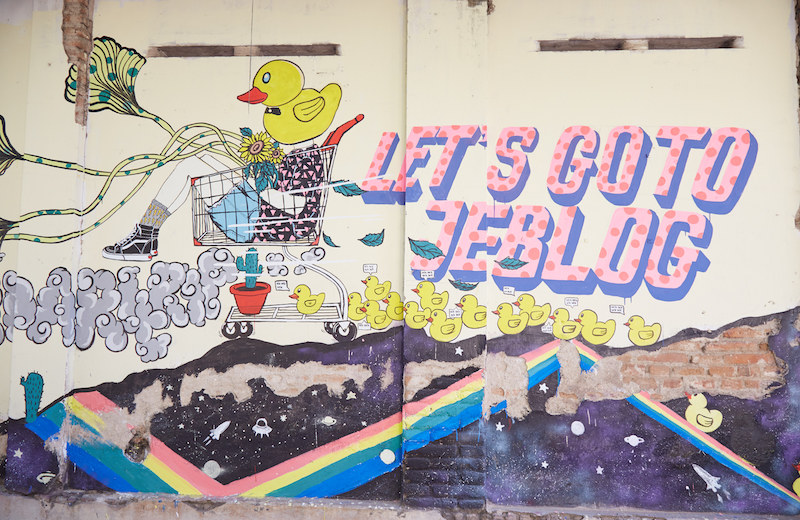
As the Sejeblog Street Art murals demonstrate, Yogyakarta is a colorful, creative city that’s also full of surprises. There always seems to be something going on, but chances are you’ll only learn about it through word of mouth or by complete coincidence.
The Jogja street art scene, along with the numerous contemporary art galleries in the city, make Yogyakarta an absolute must-visit for any art lover traveling to Asia.

Mural by Bambang Nurdiyansyah
Additional Info
Most English information online will mention Malioboro Street as the place to be. It’s true that there are many hotels there and it’s a convenient location that will suit you fine. I’d recommend staying further south, however.
As mentioned, staying somewhere near Jl. Tirtodipuran or Jl. Prawirotaman streets will give you easy access to many of the works pictured above. There are plenty of accommodation options here in addition to restaurants, nightlife and fantastic art galleries.
Yogyakarta is easily reachable by plane. You can fly to Adisucipto International Airport from Jakarta, Denpasar (Bali) and other large Indonesian cities. You can also fly directly to and from Kuala Lumpur or Singapore.
The city is also accessible by either train or bus, with trips from Jakarta lasting about 12 hours. Many people head further east after their time in Jogja, and it should be fairly easy to find a bus route to wherever it is you’re going.

Pin It!








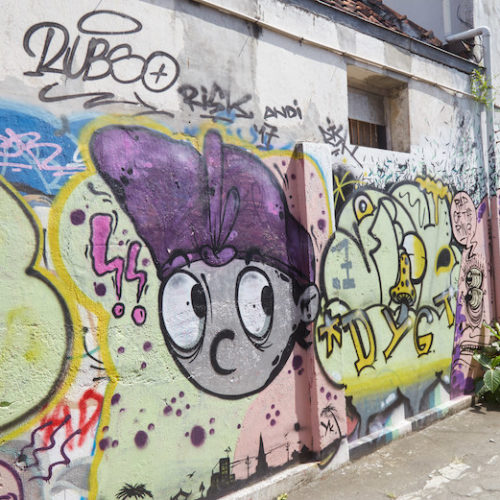



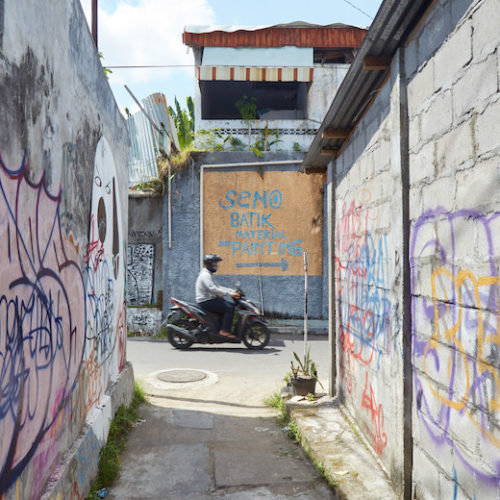


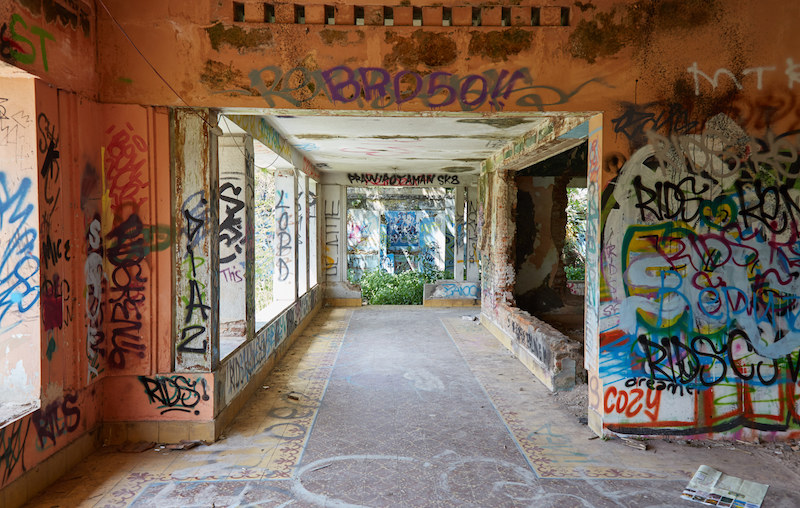



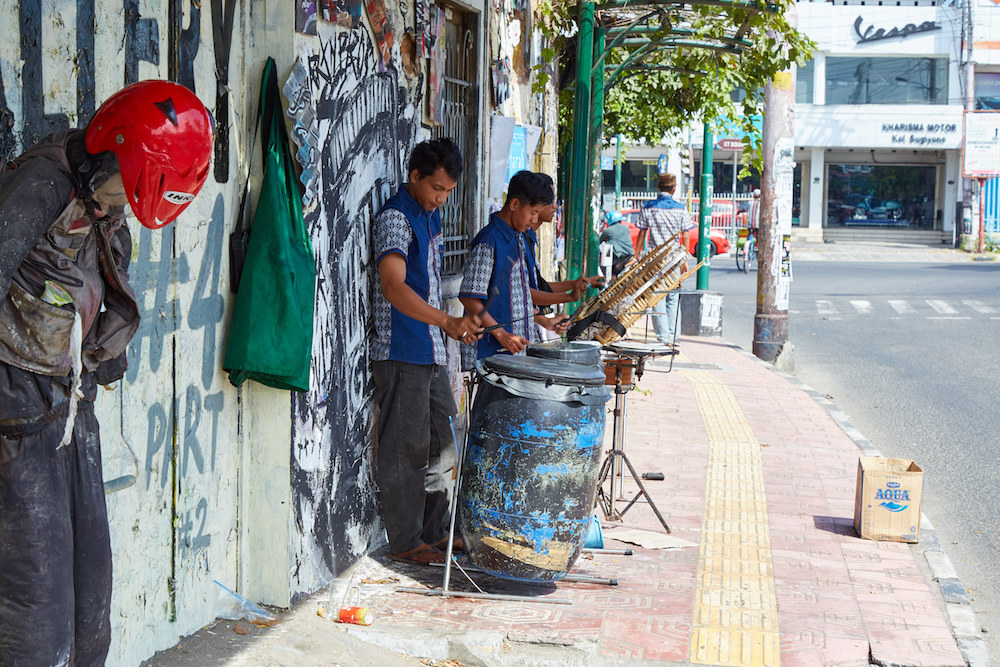



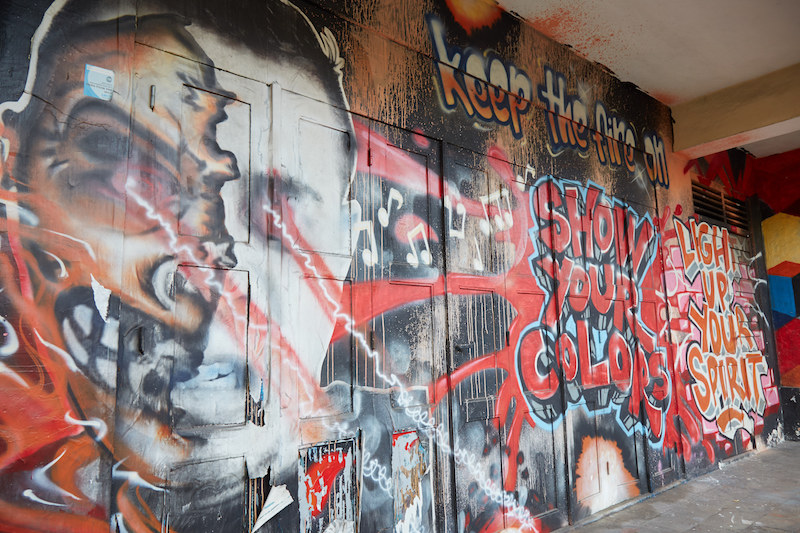










[…] aider à nous guider. Bingo, après quelques minutes seulement je trouve mon bonheur sur le site de Sailing Stone Travel, le site est certes en anglais mais très bien construit. Sur la page vous trouverez des […]
[…] would like to know where to look and what to expect, I strongly recommend you read this excellent Yogyakarta Street Art article on the Sailingstone Travel […]
[…] Download Image More @ sailingstonetravel.com […]